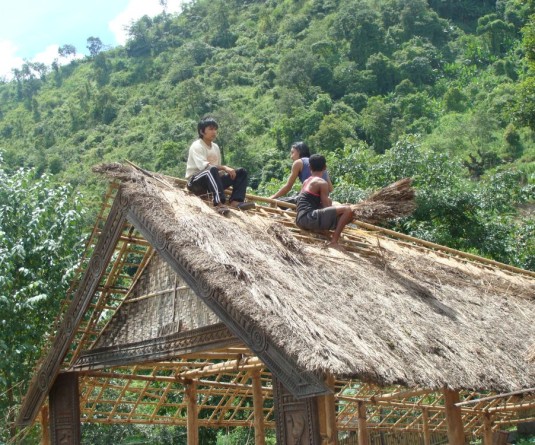WCS India, IUCN/ITHCP Phase II, Programme Manager, Bano Haralu addressing the Nature Education workshop in Kuda INN, Dimapur on the importance of tigers as bio indicators. (Photo Courtesy: WCS-I)

Youths lead conservation efforts in villages around Ntangki National Park
Imti Longchar
Dimapur | July 13
In a remarkable initiative, youths are now leading conservation efforts in villages surrounding Ntangki National Park under Peren and Dimapur districts.
Under the guidance of the Wildlife Conservation Society India’s (WCS-I) Integrated Tiger Habitat Conservation Programme (ITHCP) Phase-II, these young leaders are now the voice of environmental protection, promoting sustainable practices and environmental awareness.

Since the ITHCP inception in 2022, the villages of Manglumukh, Beisumpuikam, Nsenlo, Phelhang, Nkio ‘B’ and Ikiesingram have seen notable transformations. Hunting has noticeably decreased, and timber is being felled selectively. The community has also started rejecting outsiders who come to hunt or fish in their forests and rivers, signaling a strong shift towards sustainable practices.
WCS-I has appointed 20 ‘youth partners’ across these villages. These young leaders are receiving extensive training in ecology, pollination, herbarium and the use of various apps for documenting their forests and community lands. They are also learning to use camera traps and GPS for land mapping.

In an interaction with The Morung Express, Programme Manager of the ITHCP project, Bano Haralu said the youth partners play a critical role in their villages, acting as connectors between their communities and the WCS-I. “They facilitate meetings with village councils and other organizations, sharing their knowledge on conservation and sustainable practices which they have learnt from the WCS-I trainings and workshops,” Haralu highlighted.
“Earlier, I had no idea about conservation. But after joining WCS-I realised its importance. Although it’s challenging to convince everyone, I have persuaded my father and brother to stop hunting,” Nemneithem, a youth partner from Phelhang village said while sharing her journey at a nature workshop organized by the WCS-I recently in Dimapur.
She noted that while hunting has decreased by around 50 % in her village, changing long-standing habits is a gradual process. “Though I try to dissuade the villagers from hinting, being a woman, they often don’t heed my voice. However, my family members have quit hunting after my appeal,” Nemneithem said.

Reflecting on his experience, Ramkuahingba from Ikiesingram village, a former hunter and teacher, said he has completely stopped hunting and now focuses on spreading awareness in the community. “It’s a challenge to break the habit of hunting, but we are making progress,” he said, highlighting the difficulty of overcoming a practice that has been ingrained for centuries.
“There is a tree in my backyard frequented by birds; I no longer shoot them or allow others to hunt there. Although people sometimes don’t heed our plea, many village hunters have surrendered their weapons,” Ramkuahingba revealed. He expressed the need for more youth partners to for wider impact.
Pehiachanglu of Nkio ‘B’ village observed that hunting has significantly decreased, and timber is used more judiciously in his village. “Before, we wasted parts to the tree, but now every piece is used efficiently. He observed that the younger generation is more receptive to conservation, and changing the mindset of elders remains difficult.”
He also pointed out that opportunity for alternative means of livelihood presented by the WCS-I for the villagers, has helped gain their support for conservation.

Ranggalok, another youth partner from Ikiesingram village said villagers are now even mulling on erecting signboards to discourage fishing along rivers. He also said the trend of government officials and VIPs calling on hunters from the village for hunting and fishing in exchange for money and booze are frowned upon.
“Earlier, every house had a gun, and village authorities couldn’t enforce resolutions to safeguard biodiversity. But now, the mindset is changing, and we see more community responsibility towards protecting our environment,” Ranggalok, who discarded all his hunting equipment including an airgun and battery-operated fishing rod, emphasized.
Ntangki has been under assault since statehood
Elaborating on the ITHCP project, Bano said Ntangki National Park, which remains a critical animal corridor and potential tiger habitat, has been facing severe environmental degradation for the past 55 years. Citing a recent study by the Nagaland Zeliang People’s Organization, Haralu revealed that since statehood, approximately 60 truckloads of timber have been extracted daily, severely impacting the landscape.
Ntangki National Park is located in a unique geographical position. Situated between Assam’s Karbi Anglong district, Kaziranga National Park, and Myanmar, the park is strategically placed to serve as an animal corridor and a potential tiger habitat. The last tiger sighting in Ntangki was in 2003.
The WCS-I is implementing the ITHCP partnering with local communities in conservation to conserve critical tiger habitats in North-East India. The conservation project focuses on community-led efforts to reduce pressure on tiger habitats, improve local governance, and empower communities to monitor and implement their regulations in council-conserved areas and community forests, Haralu explained.
Haralu highlighted the critical role of youth, emphasizing their importance for the future of this landscape and North East India as a whole. She said the project aims to engage the next generation in sustainable land management and conservation practice.
Recently, the WCS-I organised a Nature Education workshop for the youth partners where they were taught on tools about ecology, and also how to use some of the apps that are available online where they can start documenting their own forest, own community land and upload these findings.
“These are some of the tools to connect young people with the world of conservation. We found out that technology is a good bridge to create this communality,” Haralu highlighted. She said the youth partners have also finished the first phase their herbarium collection.
“WCS India is only a catalyst in the landscape,” Haralu maintained, and its objectives are to support the activities of the forest department and engage with communities in areas that have prior consensus and approval of the community in project sites.






